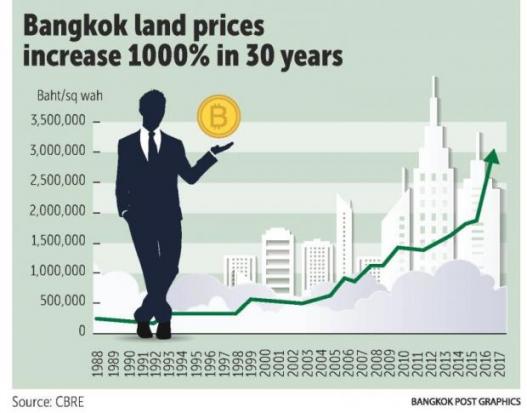CBRE: Bangkok land prices rocket
Land prices in central Bangkok have increased by 1,000% since 1988 when property consultant CBRE established an office in Bangkok.
Land prices rose dramatically during the Asian Tiger boom years from 1988-1996 before the market came to a grinding halt in the 1997 financial crisis. Price growth resumed in the early 2000s and there has been a rapid escalation of prices over the past two years for prime central business district (CBD) sites.
Two landmark transactions in the late 1980s were the acquisition of an eight-rai site on Sathon by the original developer of the abandoned Empire Tower for around 125,000 baht per square wah and the acquisition of a 21-rai site on Wireless Road, which was then the Standard Chartered Bank manager’s house, by the M Thai Group for around 250,000 baht per sq w. The plot was developed to be All Seasons Place.
The latest sale on Sathon was the eight-rai Australian Embassy plot for 1.45 million baht per sq w in 2017. In Lumpini, SC Asset paid 3.1 million baht per sq w for an 880- sq-w site on Lang Suan Road. The largest land sale in terms of value was the sale of the 23-rai British Embassy site in 2018 to the Central Group/Hongkong Land joint venture.
CBRE says the increase in land prices has not been uniform and there has been a huge change in the development patterns in Bangkok.
Historically, the commercial city centre was on Charoen Krung Road and the government buildings were on Rattanakosin Island. In the 1950s and 1960s, the commercial centre moved to Silom and Surawong roads.
Bangkok grew in the 1970s and 1980s, but did not have a clearly defined city centre and development spread as new roads were built, but this has changed.
The two big changes have been the opening and extension of the mass transit system with the first skytrain line in 1999 and the first MRT line in 2004.
The mass transit lines have changed the way of life in Bangkok. By the mid-2020s, Bangkok should have about 460 kilometres of mass transit lines, outstripping the 402- km London Underground system.
The popularity of Bangkok’s mass transit routes with over 1.2 million users a day has increased land values next to stations, but not every line or station is equally attractive. Land values have been partially determined by the popularity of a line and a station.
“The other big determinant of land prices has been urban planning and building regulations, particularly those governing how much space can be built. Obviously if less space can be built on a site then the land is worth less,” said Kulwadee Sawangsri, executive director of capital markets for investment and land at CBRE Thailand.
Planning and building regulations have become increasingly stricter and more sophisticated and have become a key factor in determining land price.
In the 1980s and 1990s, Bangkok spread further outward, but in the 2000s, Bangkok has become more inward looking with the adoption of high-rise condominium living and the growth of modern office space. The city centre is becoming more clearly defined and the next round of development will be built on many of the remaining under-utilised sites such as the 105-rai Suan Lum site of the One Bangkok development on the corner of Rama IV and Wireless roads.
Land prices are starting to form a much greater proportion of total development costs as they have risen at faster rates than construction costs. Total development costs have risen, mainly due to the increase in land prices, driving condo prices higher and raising the revenue needed to make rental projects feasible.
CBRE expects central Bangkok will continue to be the most preferred location for the best hotels, offices, retail centres, residences and other types of buildings. Bangkok will have a clearly defined city centre with extended development along the mass transit line routes concentrated in clusters around the stations.
The rate of increase of land prices will depend on the level of development activity and the returns that can be generated from development. This will vary depending on what can be built and how much customers can afford to pay either to buy or rent in the completed developments.
As the number of freehold potential development sites in Central Bangkok declines, CBRE expects that land prices will continue to rise.
In some cases, land prices will be higher than the value of the existing building on the plot and we will see more older buildings being demolished and sites being redeveloped.
The demolition of Kian Gwan Tower I on Wireless Road and Vanissa Building on Chidlom Road are good examples. There are also plans to demolish the Dusit Thani Hotel and redevelop the site. So far, it has only been single ownership buildings that have been demolished.
The condominium law requires 100% of co-owners agree to revoke the condo, enabling it to be sold and redeveloped. This has not happened to date, although there are some condos where the total value of all the units is less than the vacant possession value of the land where the condo has been built.
The sale of all units and the redevelopment of the site has taken place in other countries, particularly in Singapore where the number of co-owners needing to agree to a block sale is lower. CBRE thinks it will be very difficult to get 100% of condo owners in Bangkok to agree to sell all the units to a developer.
“Assuming that planning regulations do not change and the amount of space that can be built on sites remains the same, then Bangkok’s CBD land prices are likely to continue to rise,” said Aliwassa Pathnadabutr, managing director of CBRE Thailand, who has worked for the company for 30 years.
She said the gains will be in line with the economy and property development cycle.
Source: https://www.bangkokpost.com/business/news/1501914/cbre-bangkok-land-prices-rocket


 English
English




